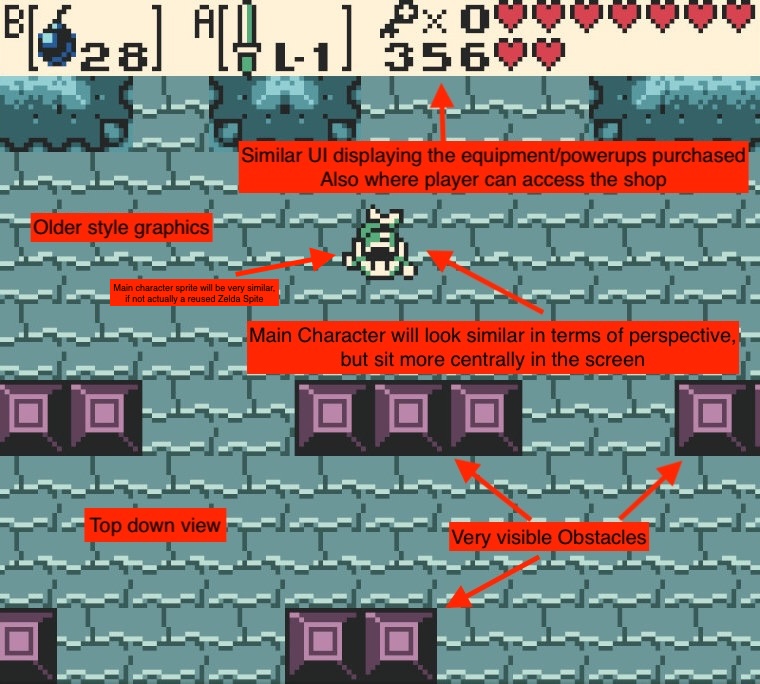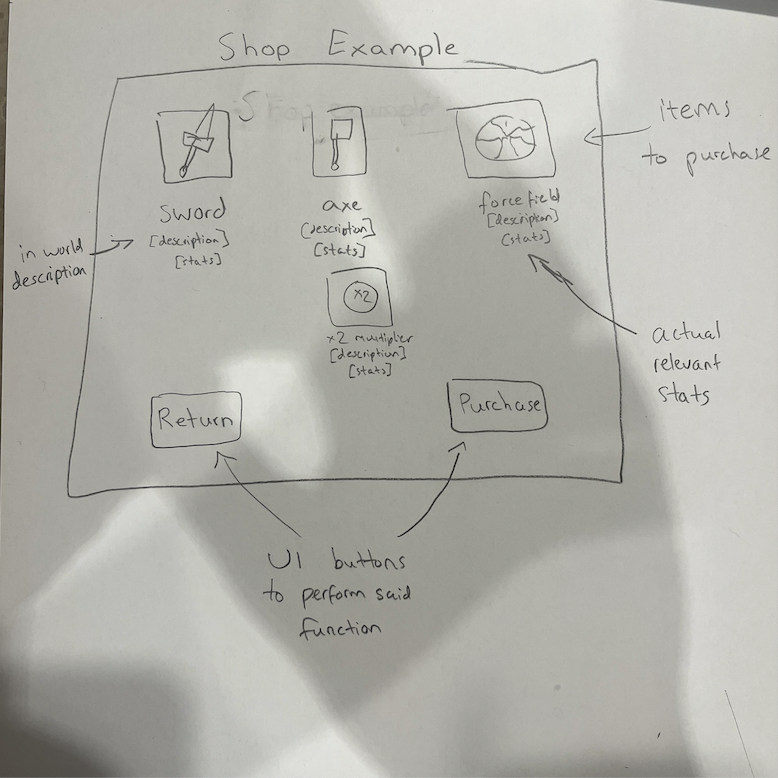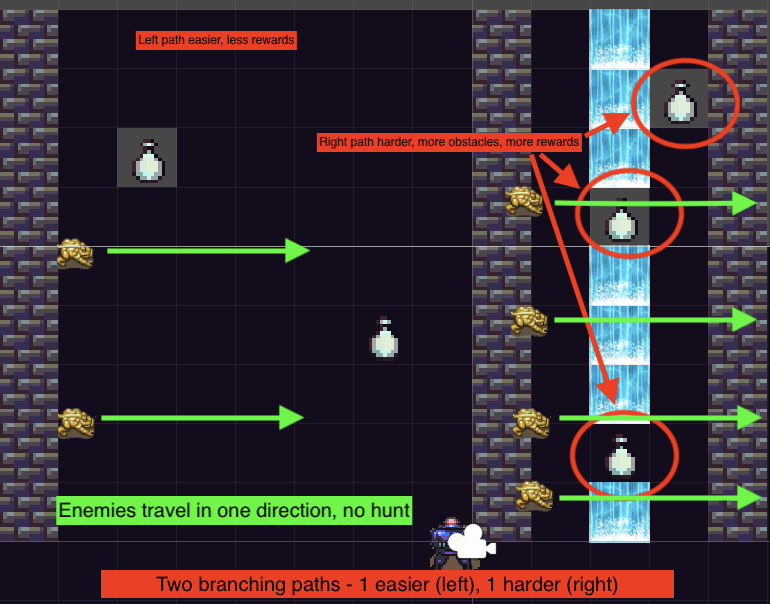Devlog #1
KIT109 CONCEPT DEVLOG
WORKING TITLE
No Red Light
CONCEPT STATEMENT
Dodge, weave, or fight your way through loads of enemies in this simple-to-play yet addictive casual game. Use your skills, and your brains, to figure out the best path forward to reach the end goal.
GENRE
Casual Indie game in terms of playthrough longevity and base complexity, but with RPG-like elements from the added shop system, inventory system and tactical replayability.
CONCEPT CREATION PROCESS/AREA (E.G. SUBTRACTIVE DESIGN, ANTI-GAME, MASHUP, ETC.) AND INFLUENCES. 400 words
The aim of the game is to finish all 5 stages (just get to the finish line) with as many points as possible, while avoiding enemies that can kill you. It is inspired by a mix of different games; the one for the enemies in particular is popular Indie game Crossy Road (Hipster Whale). In Crossy Road, the AI enemies are relatively simplistic (they don’t hunt or flee the player; they have a set path and it is up to the player to avoid them). Though it works well and still requires the player to focus and avoid, this kind of AI enemy would be much easier for me to program instead of more complex hunting AI, so I can focus on the other half of the game which is racking up points. I also struggled with the animation side of things in the Practicals of this unit, so while I could certainly get enemy animations working to some degree, I would prefer to dedicate more time around building the game’s depth rather than struggling to incorporate complex animations.
In recent playthroughs of different single-player games (like RPGs), I found I enjoyed increasing my inventory to add tactics into the mix. One particular game I liked it Final Fantasy XVI, in particular a DLC minigame called Kairos Gate where it sends the player through 20 boss stages. In between each stage, the player can make upgrades to their character using points they obtained by how well they performed. These upgrades then are fed into the next battle, and therefore increase battle performance, which then means more upgrades, and so it goes around. I really liked this tactical design where the player performs well and based on their performance they can make their own choices on best way to increase their chances.
GAME TREATMENT
At this point the plan is for the game to be set from a top-down perspective with basic, old-style graphics, the inspiration for this coming from old Zelda games I’ve played such as Oracle of Time. Though these details have not been finalised and will be experimented with throughout the development process.
After launching off the title screen, the player starts off at the beginning of stage 1 / 5, and immediately has a timer going. They must travel through the dungeon setting, following a fairly linear path, dodging obstacles and enemies that fly in from the side of the screen (that stay on their linear flight path). Being hit means they lose lives (starting off with 5 lives, more may be purchased from the store BUT that is the only way to obtain lives). There will be “coins” to obtain throughout the stage, which add a lot points, but I plan to place them in areas that may be more difficult to reach, thus requiring more time and a lesser score bonus by the end.
Once the player reaches the end of the stage, they will have the chance to visit the shop2 or to continue on to the next level. The shop will provide things to temporarily protect the player from damage, a points multiplier, extra lives, or even weapons, which can all either add to the points tally, or make it easier to reach the goal (but cost a lot of points to purchase in the first place). The player may choose to purchase anything they can afford, or just skip and save their points. Once the player finishes all 5 levels, they will be given a total score.
The game will NOT be procedurally generated; so rather than the finishing score being based on how far the player has gotten, it will be based on the speed that the player got to the finish of each level, how many “coins” they collect through the level (which will be semi-out of the way, requiring more time to collect) and other factors. The player will start out with no equipment, requiring good scoring to use their score points to purchase things from a store. It becomes the player’s decision as to what would be the wisest way to finish the game with the highest possible score, adding a bit of replayability but still not taking too long to finish a single play through.
It will be very linear but still with some areas to be able to travel in (and a couple of branching paths3- some harder to complete, with more rewards like coins, and some easier with less rewards). It will be a dungeon-like environment, relatively dark with lots of obstacles that block passage. One weapon to be able to purchase will be able to remove these obstacles, but otherwise the player will use the paths around them where enemies will be flying around trying to hit them.
The story setting for this game will be nearly non-existent; the general premise is you are a prisoner trying to navigate to the end of the dungeons that you’re trapped in. Other than that, there is no story development at all and it is just simply not the focus of the game.
AUDIENCE
This game is designed to be a quick to play casual game with slightly more complexity, but not so much that it requires a dedicated console or gaming PC. It is meant to be quick to fire up and play, but requires a bit more time and thought process than a traditional indie game like Crossy Road. As such, the main expected audience will be casual gamers. The added complexity would be too hard for young children, but also there will likely not be enough substance for a serious gamer who puts aside dedicated time for gaming.
The game is made to be replayable; since the idea is to rack up as much points as possible but lets the player decide on which equipment and paths would suit their ability level best. Do they waste points buying equipment to improve score longer term? Do they save their points so they’re all racked up in the end, but with no bonus items to help them get there? Take the easier route to get to the finish quicker and obtain a time bonus, or take a longer and harder route that has more coins that increase score? They will be encouraged to experiment and figure out what works best to finish with the most points, but still with enough simplicity that a single playthrough should only take around 10 minutes. Therefore, ideally a playthrough of this game will be done in a single sitting, appealing likely to school-going teenagers or young adult workers who carry phones on them and have spare time during lunch breaks or public commute. The replayability will be ideal especially for those who take frequent public transport to work/school, with plenty of opportunities to take out their phone and play. For this reason, though this game will be developed for PC’s using a web browser, in a longer term development it would ideally be made for mobile devices.
The older-style graphics and darker dungeon-like setting will also appeal more to an older audience, without typical bright rainbow colours or cute graphics that might attract young children.
1Screenshot of Zelda Oracle of Ages
obtained from RPGfan.com 11th April 2025
Reviewer: Joshua LindQuist on 1st December 2023
https://www.rpgfan.com/review/the-legend-of-zelda-oracle-of-ages-3/

2Rough sketch of what the shop will include

3Displaying an example of 2 branching paths in the dungeon, the left one showing an easier path, the right one showing a harder one with more rewards

Delivery Dash
More posts
- Devlog #6: Documentation and User GuideJun 01, 2025
- Devlog #5Jun 01, 2025
- Devlog #4May 18, 2025
- Devlog #3May 11, 2025
- Devlog #2May 11, 2025
Comments
Log in with itch.io to leave a comment.
Overall a neat idea with plenty of scope to try out different features, although I recommend ASAP doing a process of game modelling as taught in the lectures to work out what is most feasible and to prioritise. For example a complex rewards/upgrade system may prove to be a lot of work, but you may be able to predict that work with a bit of research, and reduce the amount of work by sticking to just a small number of fun and interesting upgrades rather than too many. Balance between points and rewards strikes me as something that will be tricky to get right. Additionally an easy way to gain some time back might be to do fewer than 5 levels. Take a look at the Assignment 3C rubric to pragmatically choose which features to go with.
All-in-all looking forward to seeing how this one pans out, well done!